| Article ID | Journal | Published Year | Pages | File Type |
|---|---|---|---|---|
| 5448795 | Materials Science and Engineering: B | 2016 | 9 Pages |
Abstract
Broadband dielectric spectroscopy (BDS) is used to measure complex permittivity and conductivity of conducting materials for lithium batteries at frequencies from a few Hz to several GHz with network and impedance analysers. Under the influence of an electric field, there will be charge density fluctuations in the conductor mainly due to electronic transfer. These fluctuations result in dielectric relaxations for frequencies below 100Â GHz. The materials are compacted powders in which each element (particles, agglomerates of particles) can have different sizes and morphologies. In the present review, studies are reported on the influence of surface states in LiNiO2 (ageing and degradation in air) and LiFePO4 (carbon coating thin layer), and on a composite electrode based on the lithium trivanadate (Li1.1V3O8) active material. The results have shown that the BDS technique is very sensitive to the different scales of materials architectures involved in electronic transport, from interatomic distances to macroscopic sizes.
Keywords
Related Topics
Physical Sciences and Engineering
Materials Science
Electronic, Optical and Magnetic Materials
Authors
Jean-Claude Badot, Bernard Lestriez, Olivier Dubrunfaut,
